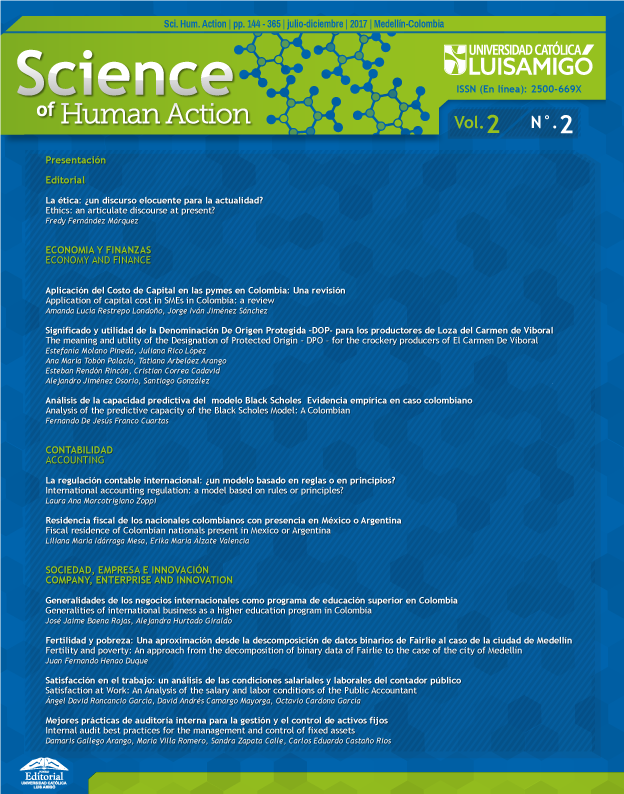Fertility and poverty: An approach from the decomposition of binary data of Fairlie to the case of the city of Medellín
DOI:
https://doi.org/10.21501/2500-669X.2476Keywords:
Fertility and poverty, Probit Model, Decomposition techniques.Abstract
This paper provides and gives a look at the relationship between poverty and fertility in the city of Medellín, Colombia. Using data from the Medellín Quality of Life Survey for 2013 and using the Fairlie methodology, it explains the differences between the two types of population (low and high income) in their decision to have children, basing on the existence of certain factors that facilitate this divergence in the decisions of the groups analyzed, level of schooling, labor participation of the mother, affiliation to pension fund, among others. For this purpose we will analyze the determinants of fertility in families and how they affect poverty. Using the model Probit under Fairlie´s decomposition techniques, we found out that there is approximately 23.3% difference in the probability that households with lower incomes will have more children than households with higher incomes, complying with the above literature.Downloads
References
Becker, G. S. (1987). Tratado sobre la familia. Alianza Editorial.
Birdsall, N. M., & Griffin, C. C. (1988). Fertility and poverty in developing countries. Journal of Policy Modeling, 10(1), 29-55.
Blinder, A. S. (1973). Wage discrimination: reduced form and structural estimates. Journal of Human resources, 436-455.
Castañeda, C. A., & Llanos, O. (2013). Fertilidad y pobreza:¿ Colombia un país machista?. Perfil de Coyuntura Económica, (19), 7-38.
Gupta, N. D., & Dubey, A. (2006). Fertility and the household's economic status: A natural experiment using Indian micro data. The Journal of Development Studies, 42(1), 110-138.
Fairlie, R. W. (2005). An extension of the Blinder-Oaxaca decomposition technique to logit and probit models. Journal of economic and social measurement, 30(4), 305-316.
Hemmi, N. (2003). The poverty trap with high fertility rates. Economics Bulletin, 9(6), 1-4.
Maldonado, S. (2007). Exclusión y discriminación en contra de la población con discapacidad en el mercado laboral peruano: Un análisis de descomposiciones paramétricas y no paramétricas. CIES. Lima.
Malthus, T. R. (1960). On population (first essay on population, 1798, and second essay on population, 1803). Modern Library, for Random House, New York.
Nakamura, A., & Nakamura, M. (1992). The econometrics of female labor supply and children. Econometric Reviews, 11(1), 1-71.
Nugent, J. B. (1985). The old-age security motive for fertility. Population and development review, 75-97.
Núñez, J., & Cuesta, L. (2006). DEMOGRAFÍA Y POBREZA EN COLOMBIA. UNIVERSIDAD DE LOS ANDES-CEDE.
Oaxaca, R. (1973). Male-female wage differentials in urban labor markets. International economic review, 693-709.
Oaxaca, R. L., & Ransom, M. R. (1994). On discrimination and the decomposition of wage differentials. Journal of econometrics, 61(1), 5-21.
Schoumaker, B. (2004). Poverty and fertility in sub-Saharan Africa: evidence from 25 countries. In Population Association of America Meeting, Boston.
Downloads
Published
How to Cite
Issue
Section
License
PUBLICATIONS POLICY
• The author must send completed the declaration of transfer of economic rights and declaration of conflicts of interest, which will be provided by the management of the magazine. This document indicates the originality of the article, which is not published in another medium and that is not simultaneously postulated in another journal.
• The author will transfer all rights to the article to the journal Science Of Human Action.
• Once the evaluation of the article has begun, the authors agree not to withdraw it until the end of the process.
• The Science Of Human Action journal will submit the articles received for initial evaluation by the Editorial Committee, in case the Committee finds the material pertinent, it will be evaluated by two anonymous referees who will determine if it is publishable. If one referee approves and the other rejects it, a third party will be appointed.
• The address of Science Of Human Action will answer within a maximum of three (3) days about the receipt of the contribution received from the author.
• Printed items will not be received. All the proponents will have to send their writings through the e-mail of the magazine.
• Partial versions of the text will not be received, that is, those that are not structurally adjusted to the type of article.
• Once the article is sent, it is understood that the author authorizes the publication of these data.
• The reception of articles does not imply an obligation to publish them. The authors are directly responsible for the ideas, judgments and opinions expressed in the articles; in such a way that the content does not compromise the thinking of the Editorial Committee or the Institution.
• Once the article is submitted, it is understood that the author authorizes the publication of the data corresponding to the author's note.
• This is an open access journal that does not charge authors for either the editorial process or the publication. All costs of editorial production are assumed by the Luis Amigó Catholic University.
ETHICS OF PUBLICATION
• The Editorial Committee, by virtue of transparency in the processes, will ensure the academic quality of the journal.
• Causes of rejection are considered: plagiarism, adulteration, invention or falsification of content and author data, which are not original and unpublished.
• In no case, the journal's management will require the author to cite it or publish articles with conflicts of interest.
• If once the article is published: 1) the author discovers substantive errors that threaten the quality or scientificity, may request its removal or correction. 2) If a third party detects the error, it is the obligation of the author to retract immediately and proceed to the public removal or correction.


